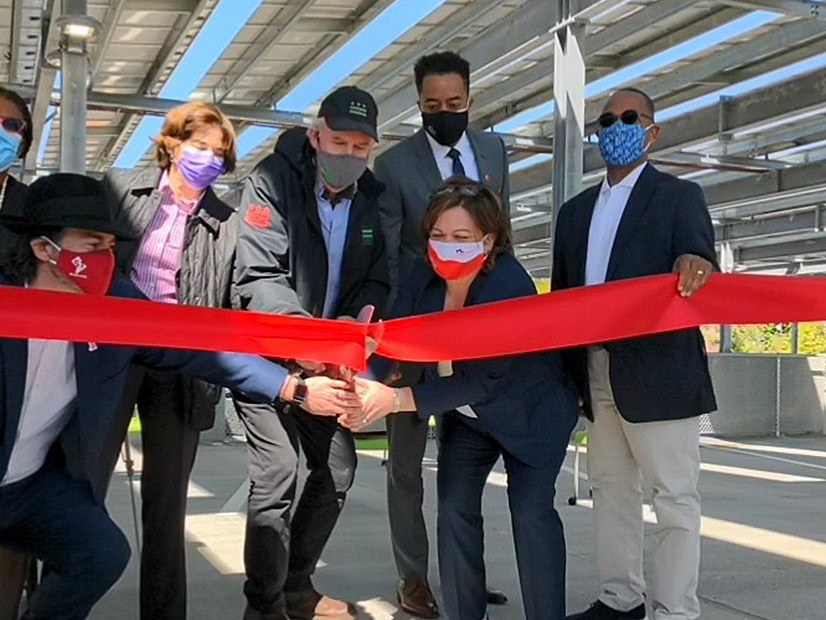“Significant” growth in distributed clean electricity generation, mainly solar energy, is driving D.C.’s efforts to mitigate climate change, according to Cary Hinton, director of the Office of External Affairs at the district’s Public Service Commission.
“The key is that we’re making significant progress in expanding the amount of renewable resources and generators that are used in the district,” he said in an interview July 20. “The district is unique in that there is virtually no electricity generation in the area we regulate, except for distributed [resources] like solar.” So, D.C. draws most of its power from neighboring states, leaving the PSC with little it can do directly about reducing fossil fuel-powered electricity, he said.
The city’s Clean Energy Omnibus Amendment Act of 2018 set ambitious goals for climate change mitigation. The new law raised the district’s existing renewable energy portfolio standard, setting goals of 100% renewable energy by 2032, with 10% of electricity coming from solar in and around the district by 2041.
Progress seems to be much more rapid on the latter goal. On June 30, the PSC issued its required Biennial Report on Fuel Mix to the D.C. Council, providing an update on the ratio of different energy sources used to generate the electricity supplied to the district. In 2020, 12.2% of the total energy sold in the district came from renewable energy sources, the report said. That contrasts favorably with the figure for PJM, which stands around 6%. In nonrenewable fuel sources, coal was responsible for 18.3% of D.C.’s power, compared to 19.4% for PJM; nuclear stood at 31%, compared to 34.5%; natural gas made up 38.1%, compared to 39.8%; and oil and other sources comprised 0.4%, compared to 0.2%.
The PSC added in an accompanying press release that, “since 2016, carbon dioxide emissions, one of the key metrics of greenhouse gases, have decreased about 20%. Nitrogen oxide, which plays an important role in the formation of smog and contributes to the problem of acid rain, decreased by roughly 52% over the same time period. Sulfur dioxide, which can adversely impact respiratory health, dropped by nearly 68% since 2016.”
On May 3, the PSC issued a separate, annual report to the D.C. Council on how the district did in meeting its RPS in 2020. That report noted “significant growth in solar energy generator applications and Community Renewable Energy Facilities (CREFs) in the district. In 2019 and 2020, the commission received and processed 1,591 and 2,835 applications, respectively.”
Much of that growth can be attributed to D.C.’s Solar For All program which was rolled out in 2018 with the ambitious target of installing enough solar across the nation’s capital to cut in half the electric bills of 100,000 low- and moderate-income residents. To date, the program has put panels on the roofs of 200 low-income single-family homes and launched 130 CREFs, saving hundreds of dollars a year for 4,000 D.C. households.
As of June 1, the more recent PSC report says, the agency has certified 164 CREFs that are associated with 19.4 MW of capacity. Since May 1, 2020, the PSC has not required CREFs to directly connect to the distribution system, which “helped implement a virtual CREF … that helps reduce the cost of establishing a CREF by avoiding certain infrastructure upgrades while maintaining safety and reliability.”
The district has also certified 11,790 renewable energy systems, including 8,623 solar photovoltaic systems that have 130.4 MW of capacity and 112 solar thermal systems that have 5.4 MW of capacity. Together, these two types of solar energy systems “account for the vast majority of these approved renewable systems — 11,491 as of June 1, 2021,” the report adds. For reference, during calendar year 2020, default electricity utility PEPCO and 46 active competitive suppliers collectively supplied approximately 9.85 million MWh to electric customers in D.C.
“We are cautiously optimistic,” Hinton said.


